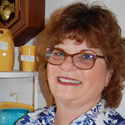Speaking of Antiquing, May 2014 – with “Fiesta Lady” Pat Montellano, Pickety Place Antiques
Merchandisers began promoting color as the Depression came to an end. Americans were more than ready to trade in their dark-colored vehicles, clothing and kitchenware and everything took on vivid hues.
In Southern California, a pottery company on Catalina Island was the first American pottery company to use glazes in bright, primary colors on simple dinnerware. Other companies began to see increased sales in their lines that also promoted solid color dinnerware. The success of these companies was recognized by The Homer Laughlin China Company in Newell, West Virginia, a small town on the bank of the Ohio River. It was there, in 1936, where Fiestware was born. The name was clearly based on the Mexican/California influence, which was so popular at the time.
A successful marketing campaign began. Housewives loved the ability to ‘mix and match’ colors. For the first time, it was not necessary to purchase a ‘set’ of packaged dinnerware. From the beginning, the Homer Laughlin China Company has had a policy of ‘marking’ its products, which has always been good for collectors.
Production began with 5 colors—a light green, yellow, cobalt blue, ivory and red. A sixth color, turquoise, was added shortly after. In 1944, due to comments made by Albert Einstein, red was eliminated, based on the fear that the uranium required to produce the red glaze was radioactive. It wasn’t until the 1950’s that the Atomic Energy Commission released restrictions of the sale of uranium oxide, allowing Homer Laughlin to resume production of Fiesta’s red glaze.
As WWII progressed, production of domestic dinnerware took a backseat to war-related activities. Homer Laughlin began fulfilling contracts for the US Navy for dinnerware to be used in the Officer’s Mess. Fiesta’s production was affected, and items began to be eliminated from the production line. These early deletions are pieces that today’s collectors clamor for—the covered onion soup, large flower vases, after-dinner coffee pot, and the nested mixing bowls.
In the 1950’s, a new Art Director took the helm and new colors were introduced. These colors, which include rose, gray, forest green and chartreuse, are now referred to as ‘50’s colors.’ More items were eliminated—egg cups, coffee servers and the demitasse cups and saucers. The company also eliminated 3 of the original colors—green, ivory and turquoise.
In early 1969, a new product came to market—Fiesta Ironstone. Immediately, the older, brighter Fiesta became a collector’s commodity. The Art Deco style was no longer in vogue. In 1973, all Fiesta production ceased. Collectors refer to this as the “Dark Period.”
After a 13-year absence, in 1986, 50 years after glazing that first plate, Fiesta was reintroduced and once again became the rage. New colors and accessories were added to the product line.
To the delight of collectors, the company’s initial marketing strategy remains today. By introducing new colors and accessories while eliminating others, Fiesta is the most collected dinnerware in the country.
Stop by Pickety Place and see the displays of truly vintage pieces, as well as contemporary (post ‘86) items that are now discontinued or retired—which are not available at the mall. It’s reassuring to know that all contemporary Fiesta is lead-free, still made in the USA and is safe for the oven, microwave, freezer and dishwasher.
Pickety Place Antiques is located at 130 N 4th Street, Jacksonville. They are open Daily from 11am-5pm. Contact them at 541-899-1912.
Posted May 2, 2014



 Pat Montellano "The Fiesta Lady," is co-owner of Pickety Place Antiques & Collectibles located at 130 N. 4th Street in Jacksonville. LIKE them on
Pat Montellano "The Fiesta Lady," is co-owner of Pickety Place Antiques & Collectibles located at 130 N. 4th Street in Jacksonville. LIKE them on